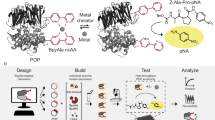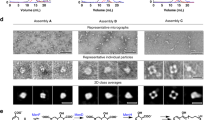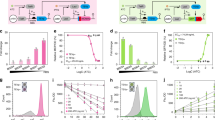Abstract
Biological electron transfer is challenging to directly regulate using environmental conditions. To enable dynamic, protein-level control over energy flow in metabolic systems for synthetic biology and bioelectronics, we created ferredoxin logic gates that utilize transcriptional and post-translational inputs to control energy flow through a synthetic electron transfer pathway that is required for bacterial growth. These logic gates were created by subjecting a thermostable, plant-type ferredoxin to backbone fission and fusing the resulting fragments to a pair of proteins that self-associate, a pair of proteins whose association is stabilized by a small molecule, and to the termini of a ligand-binding domain. We show that the latter domain insertion design strategy yields an allosteric ferredoxin switch that acquires an oxygen-tolerant [2Fe–2S] cluster and can use different chemicals, including a therapeutic drug and an environmental pollutant, to control the production of a reduced metabolite in Escherichia coli and cell lysates.
This is a preview of subscription content, access via your institution
Access options
Access Nature and 54 other Nature Portfolio journals
Get Nature+, our best-value online-access subscription
$29.99 / 30 days
cancel any time
Subscribe to this journal
Receive 12 print issues and online access
$259.00 per year
only $21.58 per issue
Buy this article
- Purchase on Springer Link
- Instant access to full article PDF
Prices may be subject to local taxes which are calculated during checkout




Similar content being viewed by others
References
Jensen, H. M. et al. Engineering of a synthetic electron conduit in living cells. Proc. Natl Acad. Sci. USA 107, 19213–19218 (2010).
Webster, D. P. et al. An arsenic-specific biosensor with genetically engineered Shewanella oneidensis in a bioelectrochemical system. Biosens. Bioelectron. 62, 320–324 (2014).
Golitsch, F., Bücking, C. & Gescher, J. Proof of principle for an engineered microbial biosensor based on Shewanella oneidensis outer membrane protein complexes. Biosens. Bioelectron. 47, 285–291 (2013).
West, E. A., Jain, A. & Gralnick, J. A. Engineering a native inducible expression system in Shewanella oneidensis to control extracellular electron transfer. ACS Synth. Biol. 6, 1627–1634 (2017).
Kracke, F., Vassilev, I. & Krömer, J. O. Microbial electron transport and energy conservation - the foundation for optimizing bioelectrochemical systems. Front. Microbiol. 6, 575 (2015).
Shomar, H. et al. Metabolic engineering of a carbapenem antibiotic synthesis pathway in Escherichia coli. Nat. Chem. Biol. 14, 794–800 (2018).
Kallio, P., Pásztor, A., Thiel, K., Akhtar, M. K. & Jones, P. R. An engineered pathway for the biosynthesis of renewable propane. Nat. Commun. 5, 4731 (2014).
Eck, R. V. & Dayhoff, M. O. Evolution of the structure of ferredoxin based on living relics of primitive amino acid sequences. Science 152, 363–366 (1966).
Harel, A., Bromberg, Y., Falkowski, P. G. & Bhattacharya, D. Evolutionary history of redox metal-binding domains across the tree of life. Proc. Natl Acad. Sci. USA 111, 7042–7047 (2014).
Sousa, F. L. et al. Early bioenergetic evolution. Phil. Trans. R. Soc. Lond. B 368, 20130088 (2013).
Atkinson, J. T., Campbell, I., Bennett, G. N. & Silberg, J. J. Cellular assays for ferredoxins: a strategy for understanding electron flow through protein carriers that link metabolic pathways. Biochemistry 55, 7047–7064 (2016).
Hall, D. O., Cammack, R. & Rao, K. K. Role for ferredoxins in the origin of life and biological evolution. Nature 233, 136–138 (1971).
Barstow, B. et al. A synthetic system links FeFe-hydrogenases to essential E. coli sulfur metabolism. J. Biol. Eng. 5, 7 (2011).
Yang, J., Xie, X., Yang, M., Dixon, R. & Wang, Y.-P. Modular electron-transport chains from eukaryotic organelles function to support nitrogenase activity. Proc. Natl Acad. Sci. USA 114, E2460–E2465 (2017).
Schlesier, J., Rohde, M., Gerhardt, S. & Einsle, O. A conformational switch triggers nitrogenase protection from oxygen damage by shethna protein II (FeSII). J. Am. Chem. Soc. 138, 239–247 (2016).
Milton, R. D. et al. The in vivo potential-regulated protective protein of nitrogenase in Azotobacter vinelandii supports eerobic bioelectrochemical dinitrogen reduction in vitro. J. Am. Chem. Soc. 139, 9044–9052 (2017).
Angeleri, M., Zorina, A., Aro, E.-M. & Battchikova, N. Interplay of SpkG kinase and the Slr0151 protein in the phosphorylation of ferredoxin 5 in Synechocystis sp. strain PCC 6803. FEBS Lett. 592, 411–421 (2018).
Moscatiello, R. et al. Identification of ferredoxin II as a major calcium binding protein in the nitrogen-fixing symbiotic bacterium Mesorhizobium loti. BMC. Microbiol. 15, 16 (2015).
Rumpel, S. et al. Enhancing hydrogen production of microalgae by redirecting electrons from photosystem I to hydrogenase. Energy Environ. Sci. 7, 3296–3301 (2014).
Eilenberg, H. et al. The dual effect of a ferredoxin-hydrogenase fusion protein in vivo: successful divergence of the photosynthetic electron flux towards hydrogen production and elevated oxygen tolerance. Biotechnol. Biofuels. 9, 182 (2016).
Yacoby, I. et al. Photosynthetic electron partitioning between [FeFe]-hydrogenase and ferredoxin:NADP+-oxidoreductase (FNR) enzymes in vitro. Proc. Natl Acad. Sci. USA 108, 9396–9401 (2011).
Mellor, S. B. et al. Fusion of ferredoxin and cytochrome P450 enables direct light-driven biosynthesis. ACS. Chem. Biol. 11, 1862–1869 (2016).
Stein, V. & Alexandrov, K. Synthetic protein switches: design principles and applications. Trends Biotechnol. 33, 101–110 (2015).
Pelletier, J. N., Campbell-Valois, F. X. & Michnick, S. W. Oligomerization domain-directed reassembly of active dihydrofolate reductase from rationally designed fragments. Proc. Natl Acad. Sci. USA 95, 12141–12146 (1998).
Thomas, E. E., Pandey, N., Knudsen, S., Ball, Z. T. & Silberg, J. J. Programming post-translational control over the metabolic labeling of cellular proteins with a noncanonical amino acid. ACS Synth. Biol. 6, 1572–1583 (2017).
Guntas, G., Mansell, T. J., Kim, J. R. & Ostermeier, M. Directed evolution of protein switches and their application to the creation of ligand-binding proteins. Proc. Natl Acad. Sci. USA 102, 11224–11229 (2005).
Fish, A., Danieli, T., Ohad, I., Nechushtai, R. & Livnah, O. Structural basis for the thermostability of ferredoxin from the cyanobacterium Mastigocladus laminosus. J. Mol. Biol. 350, 599–608 (2005).
Segall-Shapiro, T. H. et al. Mesophilic and hyperthermophilic adenylate kinases differ in their tolerance to random fragmentation. J. Mol. Biol. 406, 135–148 (2011).
Kim, J. Y., Nakayama, M., Toyota, H., Kurisu, G. & Hase, T. Structural and mutational studies of an electron transfer complex of maize sulfite reductase and ferredoxin. J. Biochem. 160, 101–109 (2016).
Kurisu, G. et al. Structure of the electron transfer complex between ferredoxin and ferredoxin-NADP(+) reductase. Nat. Struct. Biol. 8, 117–121 (2001).
Reinke, A. W., Grant, R. A. & Keating, A. E. A synthetic coiled-coil interactome provides heterospecific modules for molecular engineering. J. Am. Chem. Soc. 132, 6025–6031 (2010).
Michnick, S. W., Rosen, M. K., Wandless, T. J., Karplus, M. & Schreiber, S. L. Solution structure of FKBP, a rotamase enzyme and receptor for FK506 and rapamycin. Science 252, 836–839 (1991).
Shiau, A. K. et al. The structural basis of estrogen receptor/coactivator recognition and the antagonism of this interaction by tamoxifen. Cell 95, 927–937 (1998).
Paige, L. A. et al. Estrogen receptor (ER) modulators each induce distinct conformational changes in ER alpha and ER beta. Proc. Natl Acad. Sci. USA 96, 3999–4004 (1999).
Stephens, P. J. et al. Circular dichroism and magnetic circular dichroism of iron-sulfur proteins. Biochemistry 17, 4770–4778 (1978).
Ta, D. T. & Vickery, L. E. Cloning, sequencing, and overexpression of a [2Fe-2S] ferredoxin gene from Escherichia coli. J. Biol. Chem. 267, 11120–11125 (1992).
Bak, D. W., Zuris, J. A., Paddock, M. L., Jennings, P. A. & Elliott, S. J. Redox characterization of the FeS protein MitoNEET and impact of thiazolidinedione drug binding. Biochemistry 48, 10193–10195 (2009).
Aliverti, A. et al. Biochemical and crystallographic characterization of ferredoxin-NADP+ reductase from nonphotosynthetic tissues. Biochemistry 40, 14501–14508 (2001).
Hirasawa, M., Nakayama, M., Hase, T. & Knaff, D. B. Oxidation-reduction properties of maize ferredoxin: sulfite oxidoreductase. Biochim. Biophys. Acta 1608, 140–148 (2004).
Bak, D. W. & Elliott, S. J. Alternative FeS cluster ligands: tuning redox potentials and chemistry. Curr. Opin. Chem. Biol. 19, 50–58 (2014).
Lin, V. S., Lippert, A. R. & Chang, C. J. Cell-trappable fluorescent probes for endogenous hydrogen sulfide signaling and imaging H2O2-dependent H2S production. Proc. Natl Acad. Sci. USA 110, 7131–7135 (2013).
Navarro, F., Martín-Figueroa, E., Candau, P. & Florencio, F. J. Ferredoxin-dependent iron-sulfur flavoprotein glutamate synthase (GlsF) from the Cyanobacterium synechocystis sp. PCC 6803: expression and assembly in Escherichia coli. Arch. Biochem. Biophys. 379, 267–276 (2000).
Mulholland, S. E., Gibney, B. R., Rabanal, F. & Dutton, L. P. Characterization of the fundamental protein ligand requirements of [4Fe-4S]2+/+ clusters with sixteen amino acid maquettes. J. Am. Chem. Soc. 120, 10296–10302 (1998).
Salis, H. M., Mirsky, E. A. & Voigt, C. A. Automated design of synthetic ribosome binding sites to control protein expression. Nat. Biotechnol. 27, 946–950 (2009).
Engler, C., Kandzia, R. & Marillonnet, S. A one pot, one step, precision cloning method with high throughput capability. PLoS One 3, e3647 (2008).
Acknowledgements
E. coli EW11 and the genes encoding Zea mays FNR, Zea mays SIR, and Spinacia oleracea Fd were a gift from P. Silver (Harvard University). Cellular assay development was supported by DOE grant DE-SC0014462 (G.N.B. and J.J.S.), split Fd efforts were supported by NASA grant NNX15AL28G (J.J.S. and G.N.B.), domain insertion efforts were supported by ONR grant N00014-17-1-2639 (J.J.S.), and electrochemistry was supported by DOE grant DE-SC0012598 (S.J.E.). J.T.A. was supported by NSF GRFP and DOE SGCSR fellowships.
Author information
Authors and Affiliations
Contributions
J.T.A. designed and constructed all DNA vectors, performed the multiple sequence analysis, and did all cellular experiments. I.J.C. purified proteins and performed the lysate experiments. E.E.T. evaluated the switch substrate specificity profile. S.C.B. and S.J.E. performed the voltammetry. J.T.A., J.J.S., and G.N.B. conceptualized the project. J.T.A. and J.J.S. wrote the manuscript.
Corresponding author
Ethics declarations
Competing interests
J.J.S., J.T.A., G.N.B., and I.J.C. have submitted a patent application (No 16/186,226) covering the use of fragmented Fds as chemical-dependent electron carriers, entitled “Regulating electron flow using fragmented proteins.”
Additional information
Publisher’s note: Springer Nature remains neutral with regard to jurisdictional claims in published maps and institutional affiliations.
Supplementary information
Supplementary Text and Figures
Supplementary Table 1, Supplementary Figures 1–9
Supplementary Note 1
Full-length multiple structure/sequence alignment of plant-type Fds used for sequence divergence profile calculation
Rights and permissions
About this article
Cite this article
Atkinson, J.T., Campbell, I.J., Thomas, E.E. et al. Metalloprotein switches that display chemical-dependent electron transfer in cells. Nat Chem Biol 15, 189–195 (2019). https://doi.org/10.1038/s41589-018-0192-3
Received:
Accepted:
Published:
Issue Date:
DOI: https://doi.org/10.1038/s41589-018-0192-3
This article is cited by
-
Creation of a point-of-care therapeutics sensor using protein engineering, electrochemical sensing and electronic integration
Nature Communications (2024)
-
Rewiring photosynthetic electron transport chains for solar energy conversion
Nature Reviews Bioengineering (2023)
-
Functional spectrum and specificity of mitochondrial ferredoxins FDX1 and FDX2
Nature Chemical Biology (2023)
-
Real-time bioelectronic sensing of environmental contaminants
Nature (2022)
-
Bioelectronic control of a microbial community using surface-assembled electrogenetic cells to route signals
Nature Nanotechnology (2021)



